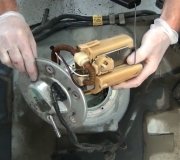You might have to use a filter from a different model. My '88, '89, and '95 Caravans use a filter that is attached with a pair of 4" long rubber hoses to the two steel lines. My Dynastys use quick connect fittings. They are 3" long metal tubes with rubber hoses crimped onto their other ends. The dealer has repair kits available for that style. The kit includes four quick connect ends, two straight and two curved, two pieces of hose, and four hose clamps. You could use two of the fittings from that repair kit and a Dynasty / Spirit filter, or the older Caravan filter which I think comes with the hoses and clamps. If your metal line is rusted, like mine was, ... Twice, you can use bulk steel brake line but remember to form some kind of ends so the rubber hoses can't slide off. That bulk line won't cost more than a couple of bucks per foot.
As for bending steel line, I put the tips of my thumbs end to end and use them to slowly flex the line while putting pressure on it to bend it. If you go slowly, you will see it start to kink before you get that far, then just move over a few inches and continue bending. Many auto parts stores rent or borrow tools now too. There are bending tools that are pretty self explanatory and not very expensive. They do a nice job by holding the tube by the sides so it can't kink.
I think you will be able to slide a rubber hose over that bulge that the quick connect end attaches to. To make it slide on much easier, use a silicone spray lube. It goes on like water and evaporates quickly. It works real nicely for hard-to-reach heater hoses too. It makes rubber parts REEEEAL slippery so they slide onto metal parts easily. The slippery goes away when it evaporates.
The Chrysler dealer's parts department has Silicone Spray Lube under the Mopar brand, but you can buy smaller cans from Walmart and auto parts stores. If you do use quick connect fittings, you might consider coating the internal spring and release collar with another Mopar product that I use almost every day. That's Spray White Lube. It's a lithium-based grease that flows in with a liquid that evaporates and leaves just the grease behind. It will help prevent that internal spring from rusting. I used it on all brake line fittings, power steering hose fittings, and alignment adjustments on every car on which I did the "new vehicle prep". That's where we checked lug nuts, screwed on antennas and license plate brackets, and made sure everything worked. When those cars came back for service years later, the alignment adjustment points and brake bleeder screws came free just like if they were new.
Even if you use rubber hoses with hose clamps, once the repair is finished, use that Spray White Lube to coat the clamps. One of my fuel system leaks over the years was due to the four clamps rusting away. You should never have to worry about replacing your fuel filter again unless, like on my van, the original filter actually started leaking at the seam at 180,000 miles. Chrysler filters rarely become plugged but a lot of people replace them thinking they're going to solve a problem. Your Neon might be different, but on most Chryslers with a pressure regulator by the engine, and a fuel return line to the tank, you will never solve a running problem by changing the filter. It is more common to develop a plugged pickup screen in the tank, which also happened to my '88 daily driver. The symptom was engine stalling when the largest volume of fuel was supposed to be flowing which was, believe it or not, during coasting. After fighting for over four hours to get through three Minneapolis interstate bypass road construction projects, the van ran fine at highway speed, then stalled when I let up on the gas three hours later at the turnoff for my town. Under any kind of load or heavy acceleration, the engine ran fine. Let up just a little on the gas and it would die and not restart until I had waited about a minute. I became real good at turning the engine off, coasting for a half mile to the next stop light, then restarting the engine just in time to take off again.
If you want me to, I can explain why the largest volume of fuel flows during coasting, but it is enough to just understand that 99 percent of the fuel flowing through the filter goes through the pressure regulator and right back to the tank. Just a tiny taste is bled off to go through the injectors and into the engine. When that larger volume is requested, that's when the plugged pickup screen becomes a problem. Mine was full of rust-colored mud.
Caradiodoc
Tuesday, September 7th, 2010 AT 3:31 AM


